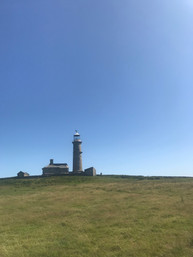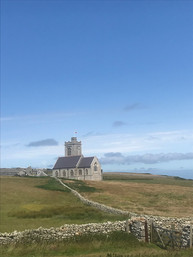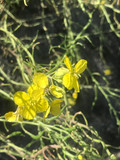Lundy Island
- Joel Bond Travels
- Jul 22, 2019
- 4 min read
If you've never been to Lundy Island, put it on your bucket list. This narrow stretch of granite located 8 miles off the coast of Devon, England where the Bristol Channel meets the North Atlantic is remarkable in its pristine beauty. Lundy Island is home a score of special designations and classifications, including Site of Special Scientific Interest and an Area of Outstanding Natural Beauty. At 3 miles long and half a mile wide, it's easy enough to cover Lundy Island on foot in a day -- but I guarantee you, you'll need more than a day. Most visitors never make it further than the quarter-wall mark, owing to the wealth of beauty and things to see.
Why is Lundy Island so special?
Well, for starters, it's somewhat of a geological anomaly. Perched as a lone granite outcropping in the north Atlantic, the island is thought to be the remnants of a volcanic plug which cooled tens of thousands of years ago when the North American tectonic plate slipped away from the European one. It's unique location at the convergence of the Gulf Stream waters with the cooler North Sea and Bristol Channel waters means the marine wildlife diversity is unlike any other spot in the UK. Seals, anemones, jellyfish, spider crabs, giant lobsters, and shoals of fish teem in the protected waters along the eastern coastline. On land, sea birds -- most notably, puffins -- nest and breed in the summer season, migrating as far away as Brazil and Argentina (7000+ miles away!) during the winter. Endemic plant species, such as the Lundy Cabbage, are uniquely adapted to the ecosystem of the island: so much so, that the Lundy Cabbage grows only along a 2 miles stretch of the eastern coastline, carries a £20,000 fine for plucking or damaging the plant, and is not found anywhere else in the entire world.
History of Lundy Island
The island has changed hands over the centuries, belonging to establish royal families and even -- at one point -- a self-proclaimed king who minted his own Lundy money (called "puffins" instead of pounds). Pirates once made the island their home, as it was an advantageous point for seizing Caribbean mercantile vessels on their way to the busy ports of Bristol and Liverpool. King Henry the III attempted to drive out the pirates, and established a hilltop castle overlooking the southern approach to the island. However, he failed to station any guards in the castle, and it soon became a refuge for more pirating families (who undoubtedly thanked King Henry under their breath for having provided them with such sturdy accommodation for which to guard their loot). In the Victorian era, a family by the name of Heaven took ownership of the island and developed a small village on the south-eastern side, the sole part of the island that offers and reliable shelter from the full brunt of Atlantic storms rolling in from the west. The Heaven family employed large numbers of labourers to quarry the granite from the island, but business venture soon failed, and the island changed hands to a Mr. Martin Coles Harman, who subsequently declared himself king. This, of course, did not go down well with the established monarchy, and he was stripped of his self-declared title and fined a handsome sum. In the 1950s, the island came into ownership of the National Trust, who are part stewards of the island to this day.
How to visit:
Access to Lundy is restricted to 276 passengers on the MS Oldenburg boat, departing from either Ilfracombe or Bideford on the Devon coast (depending on the day and season). There are up to 4 sailings a week, and the crossing is notoriously rough owing to the convergence of ocean currents around the island. Helicopter access is available in the off-season, though winter weather conditions often mean visitors can end up stranded on the island for longer than intended.
Most visitors make Lundy a day trip from Devon; however, it is possible to stay in one of the historic and managed properties on the island, including the old lighthouse, the castle, and a number of the Victorian cottages erected by the heaven family. With limited phone signal and internet access, a stay on Lundy Island could certainly be the "get away from it all" experience you're looking for. Accommodation is self-catering, and a well-stocked grocers on the island supplies most of your needs. Where that runs short, the only pub on the island -- located centrally in the village -- is virtually always open.
The island itself hosts a resident population of 26 scientists and researchers. Apart from that, there are no other permanent residents.
What to do on Lundy:
With so little infrastructure, it's easy to dismiss Lundy as worthy of anything longer than a short day visit. However, many pleasant hours can be spent just strolling the footpaths around the island, admiring the blooming heather, the semi-feral Lundy ponies, catching site of the wild deer, or photographing the hairy, horned Highland cattle munching on the long grasses. Birdwatchers will especially enjoy the puffin nesting site and the numerous other seabirds perched on the cliffs. Visit the village built by the Heaven family, including the beautiful church. King Henry III's castle on the south coast offers stunning views down the boat harbour. Or, climb the steps to the original granite lighthouse to see the entire island from above. Clustered on the north end of the island or remains of Neolithic settlements, and a host of medieval era stone structures can be found in ruinous states along the coastal paths. Most of all, though, the pleasure of Lundy is to be found in simply being present in this biologically diverse and thriving ecosystem.
For more information about visiting Lundy, go to https://www.landmarktrust.org.uk/lundyisland/.






























Comments